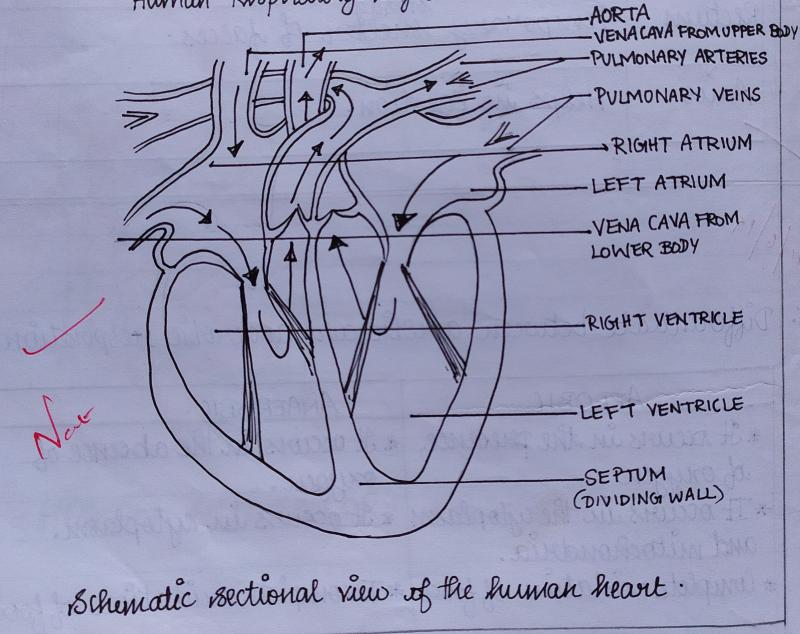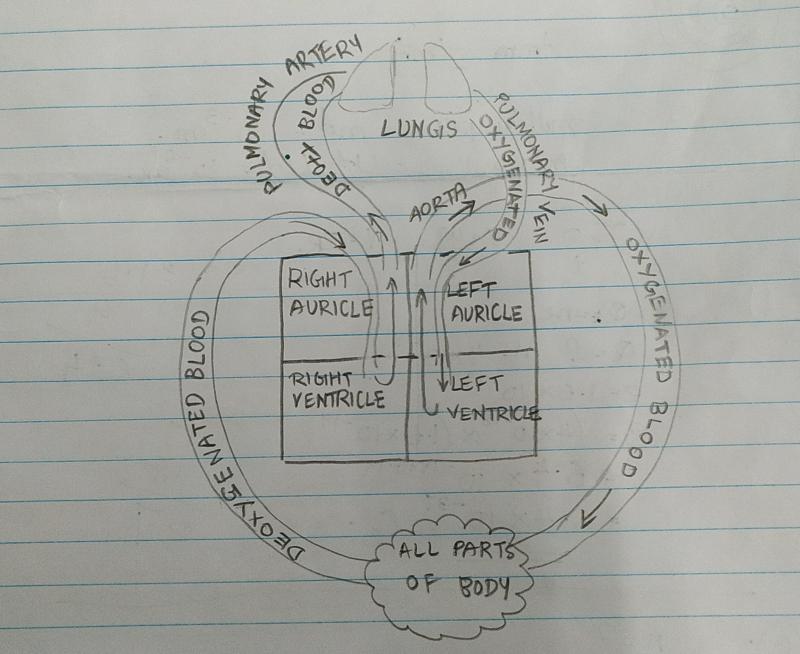
Class 10 CBSE Science : Biology Lesson 6 | Life Processes Part 4 – Transportation
1. Short Note on Heart
Ans :
- Heart is the pumping organ which is used to pump the blood to different parts of the body.
- It is as big as our fist and it protrudes more to the left of our body
- Four Chambers – Right Atria, Left Atria, Right Ventricle, Left Ventricle
- Pulmonary Vein brings oxygenated blood from lungs to the left atrium
- From left atrium, it contracts, left ventricle expands and oxygen flows into left ventricle.
- From left ventricle, contracts into aorta
- Aorta takes oxygenated blood to all parts of the body.
- From all parts of the body, dexoygenated blood is carried by vena cava into the right auricle/atrium and squeezed into right ventricle.
- From right ventricle to pulmonary artery, which takes the blood to lungs for oxygenation.

2. Diagram of Human Heart

3. What type of Heart does Fish has?
Ans:
- 2-chambered heart
- Blood is pumped to gills —> Oxygenated and —> Goes to the rest of the body
- Only one cycle
4. What is Blood Pressure?
Ans: The Force which blood acts on the walls of the vessels is called blood pressure. Pressure is more in arteries than veins.
5. Difference between Systolic Pressure and Diastolic Pressure.
Ans:
| Systolic Pressure | Diastolic Pressure |
|
|
|
|
|
|
6. Short Note on Blood Pressure.
Ans:
- Blood Pressure is measured by Shygmomanometer.
- High BP is called Hypertension.
- It is caused by constriction of arterioles – resistence of blood flow increased.
- Can cause artery rupture and internal bleeding.
7. Difference between Arteries and Veins.
Ans:
| Arteries | Veins |
|
|
|
|
|
|
8. What are Capillaries?
Ans: On reaching an organ or tissue, the artery divides into smaller and smaller branches called capillaries which are extremely thin (about 1 cell thick). The exchange of carbon dioxide and oxygen takes place here and the capillaries join to form a vein which takes the oxygenated blood to the heart.
9. What are the uses of platelets in our body?
Ans:
- When there is an injury, bleeding occurs
- The loss of blood may affect the pumping systems.
- Thus, to avoid this, blood has platelet cells around the body.
- Whenever there is an injury, the platelet cells plug and clot the blood, so the bleeding stops.
10. What are lymphs or tissue fluid?
Ans:
- A system of tiny tubes called lymph which transport a special type of fluid called lymphocyte, that helps in fighting infection and diseases.
- It flows in one direction – body tissue to heart
- It is another medium of circulation.
- It is Light yellow in colour similar in composition to blood plasma.
- Lymph carries digested fat for the nutrition process.
11. Why is diffusion not sufficient for transport in plants?
Ans:
- For plants, soil is the richest and nearest water and mineral source.
- If the distance between soil contacting organs and food producing organs is small, then diffusion will be enough for transport.
- But in case of large trees, where this distance is large, diffusion will not help in transportation of water and food.
- Therefore, plants also need a separate system for conducting water and food material to different parts of the plant body.
12. What are the 2 pathways for transportation in plants?
Ans:
- Pathway 1 – The xylem moves water and dissolved minerals from the roots to all parts of the body.
- Pathway 2 – The phloem transports the products of photosynthesis from the leaves to all parts of the body.
13. How does Xylem work ?
Ans:
- In xylem tissue, the vessels and tracheids of roots, stems and leaves are interconnected to form a continuous system of water conducting channels.
- At the roots, cells in contact with soil take up ions.
- This creates a difference in the concentration of these ions in the root and soil.
- Water, thus flows into the roots to eliminate this difference, and then water is pushed steadily upwards.
14. What is another strategy which plants use to take up water?
Ans:
- The normal absorption may not be enough for plants. So, they use another strategy for water – Transpiration.
- Transpiration is the loss of water in the form of vapours from the aerial spaces in the leaves.
- This transpiration creates a suction – a pull which makes the water flow upward from roots.
15. What is transpiration & its uses?
Ans:
- The loss of water in the form of vapours from the aeriall parts of the plant is called transpiration.
- It helps in absorption and movement of water from the roots.
- It helps in temperature regulation.
16. Why is the effect of root pressure important at night?
Ans: Effect of root pressure is important at night because, during day time, transpiration pull becomes the major force in absorbing water. During night time, transpiration pull is not present, therefore root pressure is important.
17. What is translocation ?
Ans: The transport of soluble products of photosynthesis is called translocation and it occurs in the part of vascular tissue known as phloem.
18. How is food transported in plants?
Ans:
- The soluble products of photosynthesis is transported by the phloem and this process is called translocation.
- It also transports amino acids and other substances.
- It is helped by sieve tubes and companion cells.
- Material like sucrose is transferred into phloem using energy from ATP.
- This increases osmotic pressure of phloem and water moves into it.
- This is how food and water are moved according to plant needs.